There are different models for dog parks in the U.S.: city operated free parks, city operated fee-based parks, and privately owned fee-based parks. There are advantages and disadvantages to each kind of park. The type of park that is right for Hays depends upon the local resources and community desires (which is one of the reasons I started this blog-to let the community discuss what their needs and desires are!). Despite the dog park model that is adopted, there are some basic amenities that ALL dog parks should have. The purpose of this article is to discuss these basic needs; I am going to use the Hills Bark Park in Gage Park in Topeka as an example.
I visited the Hill’s Bark Park this summer (yes, alone…my dogs were not too happy with me! I am a BAD doggy mamma!). The park is very impressive and well organized so I took a lot of notes and snapped a number of pictures. The founders of the park, in coordination with the City of Topeka Parks and Recreation, planned a well designed, aesthetically pleasing, functional park. I would like to use their model to discuss the anatomy of a dog park.
The basic elements that are essential to all dog parks are:
At least a 6 foot tall fence: It is important to have a fence that is tall enough that dogs cannot get in or out of the park without human help. The most common type of fencing is chain link. The Hill’s Bark Park has a chain link fence that is approximately 6 foot in height. The link allows people to look into the park and those who are in the park to look out.
Separate spaces for big dogs and small dogs: Not all dog parks have this amenity, but the Hill’s Bark Park does. I have talked to small dog owners who really appreciate this feature because their dogs are intimidated and overrun by larger dogs.
A separate entrance space: This feature is essential for the safety of your dog. It is an enclosed staging ground (see above images) to leash and unleash your dogs. So, in essence, there are two entrances to a park; the first entrance into the staging ground and a second entrance into the park. This creates a double barrier to be sure that your dog does not slip out when the gate to the park opens.
A water source: It is absolutely essential to have a source of water for your dogs, especially on a hot day. Some parks have a natural source, others have a built-in fountain.
“Poop” bags and trash cans: One of the first rules of dog park etiquette is that you clean up after your dog. Therefore, a dog park needs a number of trash cans. And as an added amenity, a source of “poop” bags. In the images below you will see two kinds: the first is a place for people to deposit their recyclable plastic bags for people to use to clean up, the second is a dispenser of small “poop” collecting bags within the park. Both are handy.
A bulletin board: These are a must for any dog park. A bulletin board allows one to post the park rules, any special announcements or park events, and any pertinent information. It is also a place for the local Humane Society to list fundraisers, events, and post images of their adoptable pets. The one at the Hill’s Bark Park is particularly nice and sturdy. It is also two sided; with a side in the little dog areas and the other in the big dog area.
Shade and a place for the humans to sit: Shade is essential, especially on a hot summer day, for both human and pooch. Some parks offer chairs and picnic tables for the people to perch on. Other parks I have seen used natural items–boulders, trees, etc.–for people to relax on.
Toys: Some parks, like the Hill’s Bark Park, have toy boxes filled with balls, Frisbees, and stuffed toys, for visiting canines to play with. After play, the toys are returned to the toy box for the next pooch. The “friends” organizations come in occasionally and clean the toys or replace them. Another trend is for dog parks to install agility courses. These are particularly fun to run (especially after taking an agility class to begin training) and they give the dog a way to focus their attention if no other dogs are present.
Finally, and most importantly, a list of rules: A dog park must have rules of use and conduct and these rules must be posted in several areas. It is the responsibility of dog park users to “police” the park and ensure that not only are they following the rules, but others are as well.
I encourage you to visit the Hill’s Bark Park if you are ever in Topeka. Or, visit another dog park and let us know what other innovations they included. Your input is always welcome here.
Filed under: dog, dog park, Hays, Uncategorized | Tagged: dog, dog park, Hays, Hill's Bark Park, Topeka |


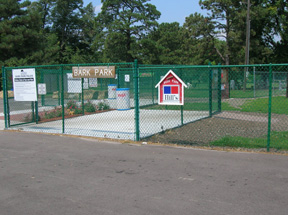

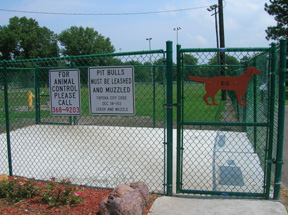
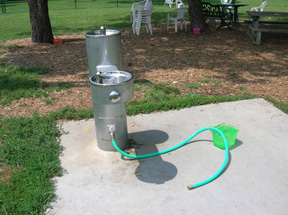
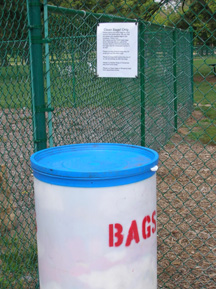
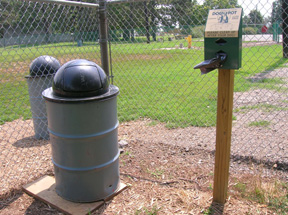
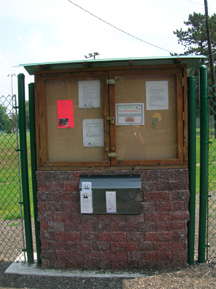

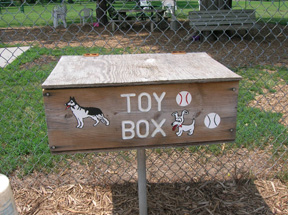
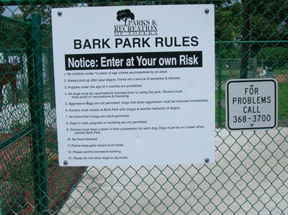
Leave a comment